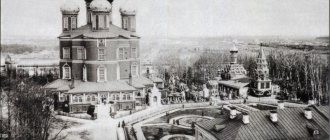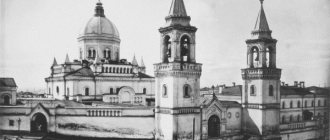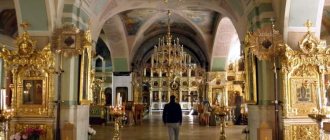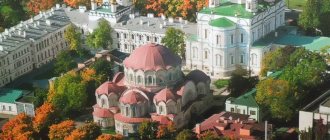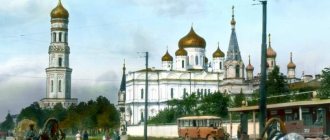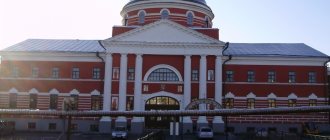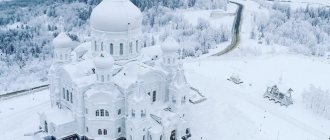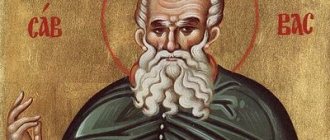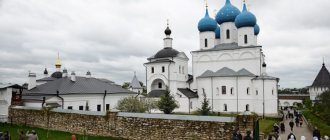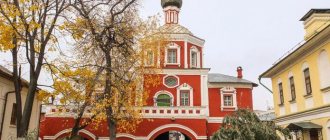The Novodevichy Convent is included in the Top 10 most interesting Moscow attractions. Once upon a time, Princess Sophia was imprisoned here, the first wife of Peter I, Evdokia Lopukhina, lived here, and Boris Godunov’s widow Irina took monastic vows here. The local history is full of a wide variety of events, so many tourists strive to visit here. Residents of the capital and surrounding areas do not ignore the monastery. Anyone wishing to visit the former monastery of monks needs to know how to get to the Novodevichy Convent by metro.
Novodevichy Convent
It is located in the southwest of the capital, next to the Moscow River. This is one of the favorite places in Moscow among tourists. It is valued for its tranquil atmosphere and rich history.
Next to it is the most famous Novodevichy cemetery in Moscow, a visit to which is even more interesting than a visit to the monastery itself, since famous figures of Russian history are buried here, and the tombs and mausoleums are genuine works of art.
The entire complex is decorated in the Russian Baroque style, however it has undergone significant changes since its foundation and is an architectural example of the history of Russia, the Russian Empire and the Soviet Union. The Novodevichy Convent in Moscow was declared a UNESCO World Heritage Site in 2014.
In addition, behind the high stone walls there is a park, the Moscow River and a small lake, which Tchaikovsky immortalized in his work “Swan Lake”. Also in the distance you can see the Moscow City financial district with its modern skyscrapers.
A visit to the monastery, including the cemetery, may take you a couple of hours. Next to the Novodevichy Convent there is a modern, renovated large sports stadium of the Luzhniki Olympic Complex, which was the main venue for the 1980 Moscow Olympics and the 2022 FIFA World Cup. You can visit it immediately after sightseeing the Novodevichy Monastery complex.
Find excursions in Moscow >>
Architectural ensemble
The beautiful five-domed Smolensk Church is located in the center of the complex, the interior of which has preserved ancient fresco painting. At the time when Princess Sofya Alekseevna was regent of her minor brothers, two more churches, a spacious refectory and an elegant high bell tower were erected around Smolensky. As follows from documents of that time, the creator of most of the structures was the architect Pyotr Potapov.
Boris Godunov, who ascended the Russian throne, surrounded the territory with fortress walls, which were subsequently significantly rebuilt. In total, the ensemble includes more than a dozen buildings for various purposes, as well as a cemetery and a small but very cozy park adjacent to the complex.
How to get to the Novodevichy Convent
The easiest way to get to the monastery is by metro. The nearest station is Sportivnaya. Also nearby is the Vorobyovy Gory station.
From Sportivnaya station:
- Bus: No. 64 or 132.
- Trolleybus: No. 5 or 15.
- Minibus: No. 64M or 5M.
Other options to get there:
- From Sokolnicheskaya - minibus No. 132.
- From Arbatsko-Pokrovskaya - the same minibus.
- From Smolenskaya - minibus No. 64.
- From Arbatskaya - trolleybuses 15 and 5.
- From Koropotkinskaya - the same trolleybuses.
- From Krasnopresnenskaya - bus No. 64.
basic information
A visit to the Novodevichy Convent complex and cemetery may take you several hours, although it all depends on your individual rhythm and the selected exhibitions to visit. Please note that the complex is constantly under renovation, so some churches and exhibitions may be closed.
- Opening hours: The monastery museums are open every day from 9 am to 5 pm. The schedule can be found on the official website: https://ndm-museum.ru/museum/services.html
- The schedule of services, if you want to attend one of them, can be found at the link: https://ndm-museum.ru/ndm/schedule-of-services.html
- The price per visit is 300 rubles. For schoolchildren, students and pensioners 100 rubles. For the opportunity to take a photo inside, you need to pay an additional 100 rubles. Visiting the cemetery is free.
- The nearest metro station is Sportivnaya, then you need to walk for about 5 minutes. The monastery complex is located at Novodevichy Prospekt, 1.
Please note that women are required to cover their heads and shoulders when entering the church, while men should wear long trousers when entering the church. If you don’t know what churches there are in Moscow, follow the link to the article.
Excursions are organized in the monastery itself and are conducted only in Russian. In the immediate vicinity of the monastery there are several gourmet restaurants: Givisatsivi (Georgian cuisine), Khinkalnaya (Georgian cuisine) and Golubka (Italian and Russian cuisine). If you want to eat fast food, check out the Kroshka Potato fast food restaurant chain.
Historical significance of the Novodevichy Convent
In addition to the fact that the Novodevichy Convent in Moscow is one of the most beautiful religious complexes in Russia, it has its own history associated with the royal dynasties. Since 2010, the temple has been managed by the Russian Orthodox Church.
If you are planning a trip to Moscow, you can find cheap air tickets on Aviasales, and train tickets on Poezd. If you prefer to travel by tour, we usually find the best deals on Travelata.
Historical significance of the community
For several centuries since its existence, the community was used to imprison female royals. The architecture of the church complex, which developed during the 16th-17th centuries, did not subsequently undergo any significant changes. The monastery is an exceptionally well-preserved model of the Moscow Baroque, for which it was declared a world heritage and accepted under the protection of UNESCO.
The current community is now in the common possession of the State Museum of History and the Russian Christian Church. Also, since 2010, the Orthodox Museum of the Moscow Diocese was opened on the territory of the sacred place.
Origin of the monastery
The history of the founding of the Novodevichy Convent dates back to 1524, during the reign of Grand Duke Vasily III. In 1514, after two Russian-Lithuanian wars, Smolensk was annexed to Russia and this monastery was named the Great Monastery of the Most Pure Mother of God Hodegetria New Maiden Monastery with a cathedral church in the name of the Smolensk Icon.
The Novodevichy Convent served as a tribute to this historical event. During the siege of Moscow (1610-1612) the monastery was devastated, but subsequently the kings of the Romanov dynasty completely restored it.
Undoubtedly, one of the significant historical figures of the monastery was the princess and regent of Russia (from 1682 to 1689) Sofya Alekseevna, who died in the Novodevichy Convent in 1704, where she was forced to flee. She became a nun and after her death was buried in the Smolensk Cathedral.
During her regency, the architectural group of the monastery was improved by the construction of three churches, a bell tower, a refectory and several chambers. This was one of the heydays of the Novodevichy Convent.
Another notable episode occurred in 1812, when French Napoleonic troops occupied the monastery and wanted to destroy the Smolensk Cathedral and the Assumption Church, but the plan was not put into action.
We moved to Antalya. We tell you everything in detail in our group. in contact with: https://vk.com/antalya2. Also watch our videos at YouTube:
In the 18th century, the Novodevichy Convent made great efforts to provide charitable activities for orphan girls; there was even a hospital and two shelters for elderly nuns. In addition, significant restoration work was carried out. A new cemetery was also planned, outside the current site.
After the October Revolution of 1917, church property was confiscated, and in 1922 the Bolsheviks abolished the monastery. In 1929, the Assumption Church, where the nuns had lived until then, was closed. Towards the middle of the 20th century, the monastery and its churches were restored for services and other religious purposes.
In 1994, church life resumed and the nuns returned. In 2004, the architectural ensemble was declared a UNESCO World Heritage Site. In addition, in 2010, the Russian government transferred the use of the monastery complex to the Moscow Diocese of the Russian Orthodox Church.
In 2016, the Bank of Russia issued 50 ruble coins (made of silver and gold) dedicated to the monastery. The Novodevichy Convent will celebrate its 500th anniversary in 2024, for which restoration and improvement measures are being carried out in the complex.
A little history
The Novodevichy Convent was founded by Prince Vasily the Third in 1524 in honor of the capture of Smolensk. There is a second side to this story: the monastery was founded after the dissolution of the prince’s marriage, and he intended to exile his wife Solomonia here.
Initially, the monastery was made of wood, but even then the walls and towers admired their beauty and height. The monastery was located in a bend of the Moscow River, guarding the crossing. The nuns did not participate in battles; if necessary, detachments of archers were equipped here. Stone walls with towers were built at the end of the 16th century.
Many noble women took monastic vows here, and the property of each of them went to the monastery. As a result, the monastery became very rich and powerful. At the beginning of the 17th century, the monastery was burned, and under Mikhail Fedorovich Romanov it was completely restored. It was then that it turned into a place of royal pilgrimage.
Under Sofya Alekseevna, active construction was going on in this territory, almost the entire architectural ensemble was erected. In Soviet times, the monastery did not function, but today it is a functioning Orthodox monastery, combined with a museum exhibition.
What to see in the Novodevichy Convent
Within the walls of this magnificent historical complex there are many interesting objects that are worth seeing. Please note that some of the buildings are only open in summer and may be undergoing restoration work. The territory of the Novodevichy Convent offers a breathtaking panoramic view.
One of the most significant buildings is the Smolensk Cathedral , the original church of which dates back to early 1524. It contains icons and unique religious paintings, the best in Moscow, and a beautiful iconostasis with wooden frames and gold coverings, dating from the 16th and 17th centuries.
This is probably one of the best religious architectural monuments in the city. The temple is dedicated to Our Lady Hodegetria and is filled with many unique examples of Byzantine and Russian art.
Within the complex you can also visit various museums and exhibitions dedicated to the historical figures of the monastery, such as the famous abbess, as well as historical events and religious life within the walls of the monastery. The exhibitions feature household items and artistic portraits. The monastery's exhibitions sometimes vary thematically.
First of all, it is worth noting the excellent preservation of the exhibits in the Novodevichy Monastery complex.
To find budget accommodation (hotels, apartments, houses) in Moscow, we recommend using the Hotellook service, where you can find a huge number of accommodation options at different prices and with high ratings.
Abbess
The first abbess of Novodevichy was the schema-nun from the city of Suzdal Elena (Devochkina). After her death in 1547, Mother Elena left a spiritual letter. The document contains unique information about the very difficult first 22 years of her tenure as abbess. Elena's name is first on the list of nuns-abbess. Behind almost everyone is a bright, extraordinary personality. After the revival of the monastery in the 20th century, Seraphima and Elisaveta (Elena) - people completely different in origin and upbringing - served as abbess.
Mother Serafima is a professor, Doctor of Chemical Sciences, from the noble family of the Chichagovs. Elena, named after the first abbess, is from a simple peasant family. Since the end of 2007, the abbess has been Mother Margarita, in the world Elena Feoktistova. After graduating from medical school, she worked as a sanitary doctor. In 2002, she was elected chairman of the parish council in the village of Kolychevo. In 2005, she became a nun with a name in honor of the Great Martyr Margaret of Antioch.
Origin of the cemetery
The Novodevichy cemetery appeared in 1898, although its official opening took place in 1904. Previously, burials took place within the walls of the monastery (since the 16th century), in the old historical necropolis, usually reserved for royal families, nobles and rich people, but originally for nuns and novices.
In 1904, Anton Chekhov was buried here - this was the first official funeral and Chekhov became one of the first celebrities buried in the new cemetery. This writer and playwright was one of the greatest representatives of Russian realism of the 19th century.
During the Soviet Union, people with high social status were mostly buried at Novodevichy Cemetery.
Currently, the cemetery contains about 27,000 burials on 7.5 hectares of land. At the entrance to the cemetery there is a map in Russian, which shows the burial places of the most famous historical figures.
Despite its funerary function, the Novodevichy Cemetery is a green area with monuments and mausoleums, which are original works of art and unique sculptural works that are associated with the life of the deceased, such as busts, reliefs, animals, airplanes, etc.
You can find excursions in Moscow on Tripster.
Icons
On the territory of the complex there are many ancient images and lists of icons (the list is not an exact reproduction from the original):
“Selected Saints”, “Vladimirskaya”, “Archangel Michael and Archangel Gabriel”, dating from the end of the 17th - beginning of the 18th centuries. and many others.
The main and most recognizable of the ancient images is “Our Lady of Smolensk,” painted in the 14th century. Placed in the Gate Church of the Transfiguration of the Lord. The image of the “Iveron Mother of God” can be seen in the Assumption.
In 1854, the list of “Consolation and Consolation” was presented from the Vatopedi monastery, located on Holy Mount Athos. For a long time it was considered lost, but was found and returned to its rightful owner.
Historical figures buried at Novodevichy Cemetery
- Konstantin Stanislavsky (1863-1938), director and theater actor, who founded his own method.
- Sergei Prokofiev (1891-1953), composer, conductor and pianist.
- Nikita Khrushchev (1894-1971), Chairman of the Council of Ministers of the USSR. Replaced Stalin from 1958 to 1964.
- Sergei Eisenstein (1898-1948), film director, author of masterpieces, including Battleship Potemkin (1925) and October (1928).
- Dmitry Shostakovich (1906-1975) - composer and pianist, author of operas and film scores.
- Mstislav Rostropovich (1927-2007), the best cellist of his time and conductor.
- Boris Yeltsin (1931-2007), former president of Russia, is covered with the country's flag, made of marble, serving as a symbolic tombstone.
In a word, this is a beautiful and at the same time sad place, a real open-air museum, quiet and calm.
We recommend that you visit the website: https://novodevichye.com/, where you can find a complete database with alphabetical indexes, as well as indexes by profession or thematic area of buried individuals.
Everything that is useful for every tourist on a trip:
- You can find and book tours online at Travelata and Onlinetours.
- You can book and compare hotel prices on Hotellook. And the apartments are on Airbnb.
- You can choose the cheapest air ticket among all airlines on Aviasales, and a train ticket on Poezd.
- Find excursions around the world on Tripster.
- Buy insurance and not worry about your health at Cherehapa.
- Rent a car to see even more interesting places on Economybookings. Or a bike on BikesBooking.
- Book airport transfer Kiwitaxi.
(Visited 844 times, 3 visits today)
